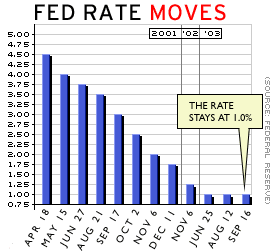NEW YORK (CNN/Money) -
Federal Reserve policy makers painted a mixed picture of the U.S. economy at their meeting in August, according to minutes of that meeting released Thursday.
Though consumer spending, government spending and the housing market were strong, industrial production and business spending were only so-so, and the labor market remained weak, the minutes said.
At that meeting, the Fed's policy-making committee, the Federal Open Market Committee (FOMC), voted unanimously to keep its target for the federal funds rate, an overnight bank lending rate that forms the basis for other banks' prime lending rates, at 1.0 percent, the lowest in more than 40 years.

The Fed made a similar decision at its policy meeting this week. Minutes of that meeting will not be available until Oct. 30.
In its August meeting, policy-makers noted there was significant "slack" in the economy -- including nearly 9 million people still unemployed and factories using just 75 percent of their production capacity -- that would keep inflation tame, even if the economy was stronger for several quarters, allowing them to keep rates low for an unusually long time.
The Fed cuts rates to spur economic growth and raises them to cool the economy down and fight inflation. It's made 13 rate cuts since January 2001 to fight the effects of a recession, terror attacks, corporate scandals, a bear market in stocks, two wars and other woes.
| Related stories
|

|
|
|
|
Despite the flood of stimulus, the economy has been unable to sustain strong economic growth, and the labor market is mired in its longest slump since World War II.
Though many economists, including some at the Fed, believe the current rebound in economic activity might be sustainable, policy makers in August noted there were still risks, and some even thought it was possible for inflation to slow down even further.
While falling prices are a good thing for consumers, some economists believe they can be bad news for corporate profits, forcing cost-cutting layoffs and, eventually, broader economic weakness.
Communication breakdown
In the August minutes, the Fed acknowledged problems communicating with the bond market after its June policy meeting. Before that meeting, expectations that the Fed might cut the fed funds rate by half a percentage point and employ "unusual" policy measures, such as buying long-term Treasury bonds, helped drive longer-term interest rates to historic lows.
Low rates gave a boost to the housing market and allowed homeowners to refinance mortgages at lower rates, putting more cash in their pockets and boosting consumer spending, which makes up more than two-thirds of the economy.
At the June meeting, however, central bankers cut the fed funds rate by just a quarter of a percentage point, and subsequent comments by Fed Chairman Alan Greenspan and other officials convinced the bond market the Fed had no intention of buying longer-term bonds. A selloff in the bond market ensued, and -- since bond yields move opposite to price -- interest rates soared.
The Fed said it held a special meeting on Sept. 15, a day before the latest policy meeting, to talk about ways to improve communication. In what will likely be a disappointment to some analysts, policy-makers decided not to change their communication methods yet, and the Fed's Sept. 16 statement announcing its decision to keep rates steady matched its Aug. 12 statement almost word-for-word.

|

